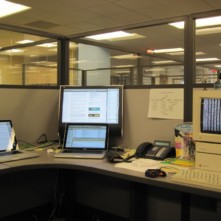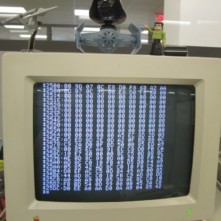The annual Apple II convention known as KansasFest has been a highlight of my year ever since I began attending in 1998. That enthusiasm must’ve been noticeable, as in 2001, I was asked to serve as roast emcee. I was nervous about performing in front of such an esteemed crowd, so I asked Ryan Suenaga and Eric Shepherd how I should respond to the invitation. Ryan’s response: "Yes." His simple, straightforward answer bespoke of a calm confidence in my ability to rise to this task. Emboldened, I accepted.
It was with a similar confidence in April 2002 that KansasFest’s then-committee chair Steve Gozdziewski added me to the planning committee. I say "added" instead of "invited" because there was no discussion beforehand; one day, I simply received an email from list manager Devin Reade asking at what email address I would like to receive committee emails. I expressed my surprise to Steve, who replied: "Oops! Seems I’ve done this backwards – I should have talked to you first:( As you’ve learned, we’d like to add you to the KFest-Admin list. It’s the ‘penalty’ you pay for all you do for KFest:)"
Once added, I introduced myself to the rest of the committee, concluding: "I’m not quite sure what I’m doing on this list, but it will probably become apparent over time." Again, Steve replied: "As of now, there are no vacancies on the Committee or I’d be proposing a more drastic ‘penalty’ for your involvement! However, there IS general agreement that you should be part of the KFest planning this year. Some of this goes on in the background via the Admin list and we’ve got more things to consider this year than last. Hope you’ll join and add what you can to make KFest the best it can be!"
That I was brought onto the committee with no particular charge had long-ranging effects. It meant that I could freely contribute wherever I saw the need, benefitting the community with whatever skills and interests I had. Over the next several years, I did just that, surviving three committee chairs, two sponsors, and a gradual replacement of nearly every existing committee member. (Only recently was it pointed out to me that their successors were all ones I nominated, which I suppose makes me Nick Fury to the KansasFest Avengers.)
Over time, my responsibilities grew from writing press releases to wrangling keynote speakers to running the Web site (I had quietly registered KansasFest.org as a backup in the event of KFest.org going down — which it eventually did). When we switched the site to WordPress using a design provided by one of my old high school buddies, I also became the group’s historian, building and maintaining an extensive multimedia database. That led to 2010, when I added the role of videographer, recording and publishing every KanasFest session. It seemed there wasn’t anything I couldn’t do.
I was heartened by the synergy I was able to bring to KansasFest. As editor of Juiced.GS, I edited an interview with Apple R&D co-founder Bob Bishop; the staff member responsible for that interview later helped put the committee in touch with Mr. Bishop, resulting in the 2011 keynote speech. And as an editor at Computerworld, I’ve encountered many storied IT professionals, such as Jason Scott, Lane Roathe, and Randy Wigginton, who I also was able to help shepherd to Kansas City.
Although I enjoyed the freedom my lack of charter provided, it also meant there was no limit to my responsibilities. Over time, I found myself doing more than I was capable of — and, more important, more than I enjoyed. The breaking point came at the KansasFest 2012 committee meeting when I realized the event had become more work than play. If this trend continued, I would end up not wanting to attend KansasFest ever again. And that would be my loss, if no one else’s. Something had to change.
Readers of this blog suggested back in March that KansasFest has perhaps the narrowest appeal to the Apple II community, given the limited accessibility a physical event offers over, say, a magazine like Juiced.GS or a podcast such as Open Apple. I’m not sure such a comparison takes into account the utter irreplaceability of KansasFest: there are other podcasts and other printed and online news outlets, but there is no other Apple II convention. It is absolutely essential for the health and growth of the community that this event continue.
But, although KansasFest, Open Apple, and Juiced.GS are all team efforts, I feel I am more easily replaced at KansasFest. Substituting my efforts on the other productions is possible but would result in a noticeable change in the tenor of the final product. KansasFest, I suspect, would be business as usual without me.
And so change has occurred. After helping produce eleven annual Apple II conferences over the course of exactly a third of my life, today marks my last full day on the KansasFest planning committee. I do this not so I can better focus on other contributions to the Apple II community; doing so would result in the same burnout I’ve already experienced. Instead I seek more work-life balance and the freedom to pursue other interests. For example, next semester I’ll be teaching an undergraduate course in electronic publishing. I’ll be happier grading my students’ papers knowing that my time needn’t be divided publishing the backlog of KansasFest multimedia. Such videos have a proven track record for attracting newcomers to the event, and I hope the committee will continue to invest in that outlet. But my job will be to invest in my students.
I’m not completely freeing myself of commitment to KansasFest, as there are still two tasks I owe to both the event and myself: to attend KansasFest, and to enjoy doing so. I will always provide the event with the presence and financial commitment of at least one attendee, and I will forever be the event’s evangelist to ensure I share the good company of my fellow Apple II enthusiasts.
Next year is shaping up to be a fantastic one for KansasFest. Already the event has a major keynote speaker in Randy Wigginton, Apple employee #6. And Dagen Brock even created a self-running demo to commemorate 2013 being the 25th annual KansasFest — a milestone we recognized only once Steve Weyhrich rewrote the event’s Wikipedia page. I can’t wait to see all these friends old and new and re-experience what it means to be a part of, and not apart from, the community.
As a non-organizer, I am again eligible to be in the running to be the event’s first registrant. You’d have to beat me off with a stick to keep me from going!


















